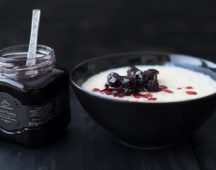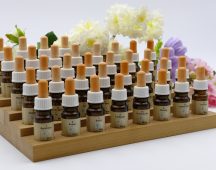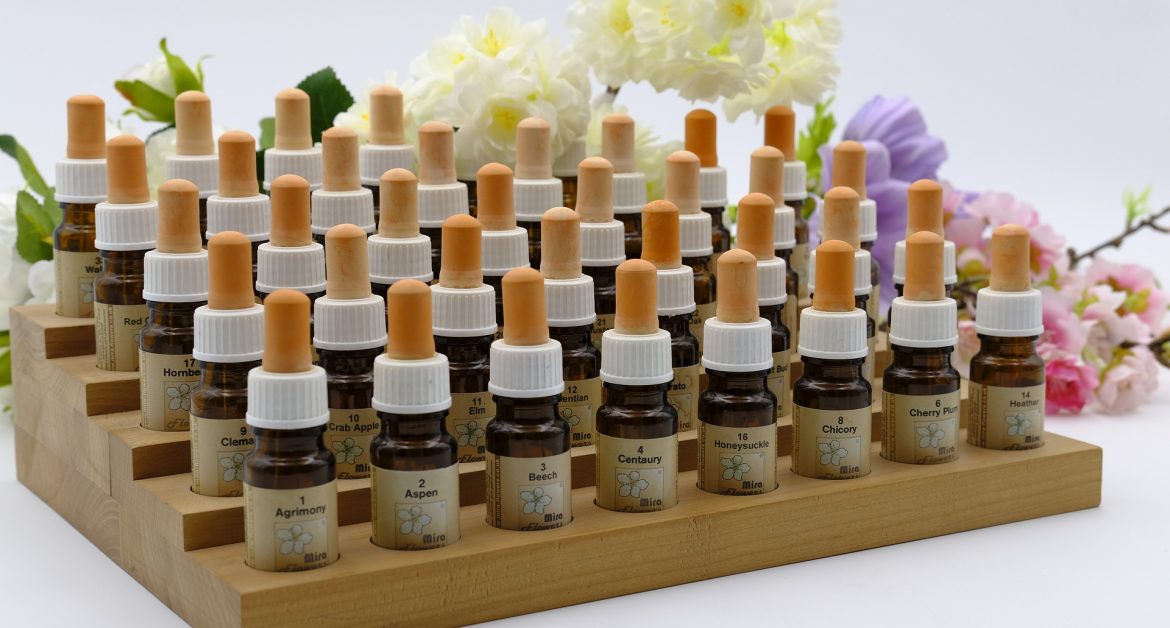
- Guestadmin
- October 27, 2016
- 11777
Corn on foot treated without surgery
GENETIC SIMILIMUM: CASE OF HELOMA DURUM (CORN)
Nambisan, Nisanth KM1; Nambisan, Smita N2
ABSTRACT
BACKGROUND: Heloma durums also known as corns are areas of hard, thickened skin that develop when the skin is exposed to excessive pressure or friction. They commonly occur on the feet and can cause pain, discomfort and they also tend to reoccur.
CASE 1: A male patient complained of multiple painful corns on plantar aspect of both foot. Surgeon advised surgery followed by 4 weeks of medication & rest for healing the wound as a result of surgery. He was treated with single dose Sulphur 200 followed Antimonium Crudum 30 TDS for 7 days. Corns cured in 10 days time and did not reappear.
CASE 2: After 15 years daughter of case no.1, complained of single painful corn in plantar aspect of left foot. Tried several treatment options including corncaps & homeopathy for about 4 months without any relief; we prescribed the same medication given to her father 15 years ago. In one months time the corn resolved and did not reoccur.
CONCLUSION: Case no.1 received medication after case taking, and case no.2 daughter of case no.1 received repetition of medication received by her father without case taking, both cases cured in short span of time. Pathogenetic trails of Sulphur & Antim crudum shows a definitive role in thickening of skin and it adapts well to persons constitutionally having thick skin. Therefore, same medicine (genetic homeopathic similimum) or constitutional medicine can be used in same disease, provided the genetic make-up is also same or similar.
More detailed study both clinical and laboratorical is needed to ascertain the role of genetic similimum in treating incurable diseases.
INTRODUCTION: Heloma Durum or Corns (clavi) is acquired areas of thickened skin (keratosis) that appear over sites of repeated or prolonged trauma to the epithelium. These lesions arise because of pressure, friction, and shearing forces of bone (through the overlying skin) against adjacent digits, metatarsal heads, or footwear. They are associated with poorly fitting footwear, underlying anatomic deformities, and high levels of activity. The formation of the center (nucleus, radix) of a corn is secondary to vascular changes and fibrosis underlying the point of maximum stress. There is marked hyperkeratosis of the stratum corneum overlying an epidermis that has otherwise the same thickness as the adjacent skin.1
Pain from corns results from their hard conical corn pointing to the bone. Corns are a common foot problem and surveys have indicated that between 14-48% of people suffer from them. Many of these will seek podiatry treatment; however, there is little evidence to indicate which current treatments in conventional medicine provide long-term resolution.2
Disorders of cornification are a group of diseases that share abnormalities in the manufacture or desquamation of corneocytes.3
Hard lesion in the plantar area is kept under a larger term Plantar keratosis which includes warts. Plantar warts are often similar to calluses or corns, but can be differentiated by close observation of skin striations. Feet are covered in skin striae, which are akin to fingerprints on the feet. Skin striae go around plantar warts; if the lesion is not a plantar wart, the striations continue across the top layer of the skin. Plantar warts tend to be painful on application of pressure from either side of the lesion rather than direct pressure, unlike calluses (which tend to be painful on direct pressure instead).4
Plantar warts are common viral infection that are usually challenging in treatment. Surgical treatment is usually not indicated since the rate of recurrences is as high as with conservative therapy, and the resulting scars may lead to the same complaints.5 Conventional treatment methods are usually invasive, have low efficacy, and need long recovery periods.6
CASE REPORT:
Case No.1: A male patient aged 36 years, forest ranger by profession, presented with multiple painful corns on plantar aspect of both foot at our OPD 3 March 1999.
Presenting complaints: Painful corns, four corns on the plantar aspect of left foot & two on the right foot. Aggravation of pain on standing & walking, more so walking bare foot on the floor.Continuous pain of stitching character.
H/o of Presenting complaints: Corns were present since about six months, for which he was taking analgesics, local application of salicylic acid and had already taken the opinion of a surgeon, who had advised him surgery followed by 4 weeks of medication & rest for healing the wound as a result of surgery, with a word of caution, that, it may reoccur. This prompted him to seek homeopathic consultation. Due to his occupation, he had to continuously walk in the forest in difficult terrain, therefore, frequently took analgesics to control pain.
Past history:
Illness/ disease: NAD
Surgical Treatment: Single Corn removal in the past.
Medical Treatment: Analgesics, Corn cap
Causation: Walking with ill-fitting heavy shoes.
Family History – No specific history except father being hypertensive.
Personal history:
Sleep / Dream: NAD
Urine / Urinary Tract: NAD
Bowel: Regular
Thirst: Adequate
Constitution: Medium built, Height: 5 feet 3 inches, Weight: 71 kgs.
Relation to Heat & Cold: Ambient
Mentals: Well behaved, yielding gentleman.
Physical General: Desire/Aversion: NAD, Personal habit: NAD
Systematic Examination: NAD
Local Examination: Corn tender +++, no signs of discharge or inflammation, striae on the corn.
With the help of Kent’s Repertory the case was repertorised with the following rubrics:
- Extremities; corns; painful
- Extremities; corns; painful; aching
- Extremities; corns; painful; stitching, stinging
- Generalities; intoxication, after; medicaments
[Table No.1]
Review fo Materia Medica:
SULPHUR: *Pain in the corns(twenty-seventh day). *About 4 P.M., and all the afternoon, constant pain in the corns, as if the boot pressed on them, and frequent alternation of a drawing penetrating pain, combined with feeling of stiffness, now in the joints of the left great toe, now in the right ankle-joint, now in the ligamentous connection of the right ankle, with the metatarsal bone (at rest and when moving), (first day). *Corns painful, as if pressed by a tight shoe. Pains in the corn of the right little toe (one hundred and twenty-seventh day). *Frequent violent sticking in the corns. *Sticking in a corn, at night, in bed. *Violent stitches in the corn, in the evening, in bed, several evenings. Sticking burning in a corn, in a wide shoe.7
ANTIMONIUM CRUDUM: *Large horny places on the skin of the soles of the feet, close to where the toes commence, which pained like corns, and always returned after having been cut out. *Great sensitiveness of the soles of the feet, when walking, especially upon stone pavement, for a long time (after seven days).8
Treatment: Sulphur 200 Single dose was given in the morning, next day onwards Antimonium Crudum 30 TDS for 7 days.
RESULT: Patient did not turn up after 7 days and it was assumed that the patient had left treatment. But, several months later the patient came back for another minor ailment, on this consultation he was enquired about his corns, this is when he reported that the corns became painless the very next days after taking Sulphur & all of them disappeared in 10 days time. In a recent conversation, the patient confirmed that the corn did not reoccur in the past 16 years.
Case No.2: After 15 years, the same patient brought his daughter, aged 18 years on 12 September 2013 with single painful corn in plantar aspect of left foot with sign of desquamation due to application of corncap.
[Figure No.1]
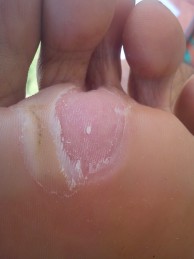
Before coming to us she had tried several treatment options in another city including corncap tapes & homeopathy. Application of corncap reduced the size for a short period of time, but, it grew back after sometime. She had received homeopathic treatment for about 4 months, without any relief, the patient could not give details about previous homeopathic medication, but, was assertive that detailed case interview was done before starting the treatment. Assuming that she might have already received the commonly indicated medicine from the previous Homeopath, we once again prescribed the same medication given to her father 15 years ago.
Treatment: Sulphur 200 Single dose was given in the morning, next day onwards Antimonium Crudum 30 TDS for 7 days followed by placebo.

[Table No.2]
RESULT: On 23 September 2013 the patient reported no pain & 90 % of the corn had resolved, on 10 October 2013 the corn had completely disappeared while on placebo.
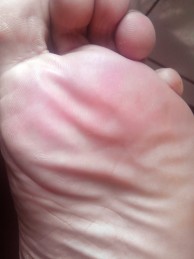
[Figure No.2]
DISCUSSION AND CONCLUSION: Heloma Durum (Corn) a so called surgical disease with sycotic miasm in the background, with high chances of recurrence, has no answer in the modern medicine other than surgical removal, which is not only painful, but, also requires immobility for 4 to 6 weeks till the wound heals up. Both the cases discussed above had tried other treatment modes before taking the above Homeopathic treatment protocol.
Pathogenetic trails (Homeopathic proving) of Sulphur & Antim crudum has shown a definitive role in thickening of skin (keratosis) and also that it adapts well to persons constitutionally having thick skin.
Determination of constitution in homeopathic case taking tries to ascertain the genetic make-up of an individual, and choosing a medicine picture of similar genetic make-up from the Materia Medica derives the right similimum, effecting a cure. Is this also true for hereditary diseases?
In above mentioned cases, case no.1 received medication after case taking, and case no.2 daughter of case no.1 received repetition of medication received by her father without case taking, both cases cured in short span of time. Here the same treatment cured both father and daughter, which indicates that the same homeopathic medicine is effective, in same genetic make-up for a given disease (genetic similimum). Since then we have used this protocol in several cases with high success rate in curing Heloma durum.
Several studies show the potential of homeopathic medicine to regulate gene expression in animal & plant models.9,10 Is the present treatment protocol also acting in the same fashion by regulating the gene responsible for predisposing corn formation? More detailed study both clinical and laboratorical is needed to ascertain the role of genetic similimum in treating incurable diseases.
REFERENCES:
- Arndt, Kenneth A.; Hsu, Jeffrey T.S. Manual of Dermatologic Therapeutics, 7th Edition. Philadelphia; Lippincott Williams & Wilkins; 2007. p. 47.
- Farndon LJ, Vernon W, Walters SJ, Dixon S, Bradburn M, Concannon M, Potter J. The effectiveness of salicylic acid plasters compared with ‘usual’ scalpel debridement of corns: a randomised controlled trial. J Foot Ankle Res. 2013 Sep 24;6(1):40. doi: 10.1186/1757-1146-6-40. [PUBMED http://www.ncbi.nlm.nih.gov/pubmed/24063387]
- Shwayder T. Disorders of keratinization: diagnosis and management. Am J Clin Dermatol. 2004;5(1):17-29. [PUBMED http://www.ncbi.nlm.nih.gov/pubmed/14979740]
- Plantar wart Available from: http://en.wikipedia.org/wiki/Plantar_wart [Last accessed on 2014 Dec 17].
- Haneke E. Differential diagnosis and therapy of calluses, corns and plantar warts (author’s transl)]. Z Hautkr. 1982 Feb 15;57(4):263-72. [PUBMED http://www.ncbi.nlm.nih.gov/pubmed/6210994]
- El-Mohamady Ael-S1, Mearag I, El-Khalawany M, Elshahed A, Shokeir H, Mahmoud A. Pulsed dye laser versus Nd:YAG laser in the treatment of plantar warts: a comparative study. Lasers Med Sci. 2014 May;29(3):1111-6. doi: 10.1007/s10103-013-1479-y. Epub 2013 Nov 12. [PUBMED http://www.ncbi.nlm.nih.gov/pubmed/24218179]
- The encyclopedia of pure Materia Medica by Timothy F. Allen, A.M., M.D. Available from: http://mm.homiyo.com & http://www.homeoint.org/allen/s/sulph-19.htm [Last accessed on 2014 Dec 17].
- The encyclopedia of pure Materia Medica by Timothy F. Allen, A.M., M.D. Available from: http://mm.homiyo.com & http://www.homeoint.org/allen/a/ant-c.htm [Last accessed on 2014 Dec 17].
- Khuda-Bukhsh AR. Potentized homeopathic drugs act through regulation of gene-expression: a hypothesis to explain their mechanism and pathways of action in vivo. Comp Ther Med. 1997; 5:43–6.
- Ganger HU. Management and control of genetic processes in cotton plants through homeopathy. Indian Journal of Research in Homeopathy. 2007;1:1-5.
Related Posts
- comments


